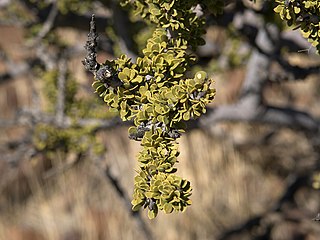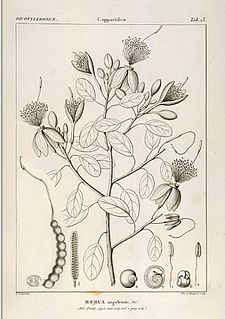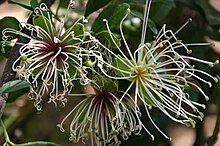
The Brassicales are an order of flowering plants, belonging to the eurosids II group of dicotyledons under the APG II system. One character common to many members of the order is the production of glucosinolate compounds. Most systems of classification have included this order, although sometimes under the name Capparales.

The Salicaceae are a family, the willow family, of flowering plants. The traditional family included the willows, poplar, aspen, and cottonwoods. Genetic studies summarized by the Angiosperm Phylogeny Group (APG) have greatly expanded the circumscription of the family to contain 56 genera and about 1220 species, including the Scyphostegiaceae and many of the former Flacourtiaceae.

The Capparaceae, commonly known as the caper family, are a family of plants in the order Brassicales. As currently circumscribed, the family contains 33 genera and about 700 species. The largest genera are Capparis, Maerua, Boscia and Cadaba.

Boscia is a genus of plant in family Capparaceae. It contains the following species:

Monotes is a genus of flowering plants in the family Dipterocarpaceae. Its name, meaning "unity" or "uniqueness" was chosen because it was the only genus of dipterocarp then known to occur in Africa. The Zambezian region is the centre of diversity for the genus.
Maerua crassifolia is a species of plant in the Capparaceae family. It is native to Africa, tropical Arabia, and Israel, but is disappearing from Egypt. Foliage from this plant is used as fodder for animals, especially camels, during the dry season in parts of Africa.

Capparis fascicularis, the zigzag caper-bush, is a plant in the Capparaceae family and is native to Africa.

Maerua cafra (DC.) Pax is a small Southern African tree belonging to Capparaceae, the caper family, occurring eastwards along the coast from Knysna, then further inland and northwards through KwaZulu-Natal and Swaziland to the Transvaal, southern Mozambique and southern Zimbabwe. The genus Maerua comprises about 60 species found in Africa and Asia.

Maerua angolensis is a 10m tall, occasionally deciduous tree of the Capparaceae or caper family, often growing on termitaria and in thickets fringing seasonal watercourses, up to 1800m. Though never common, it is widespread in tropical Africa and arid regions, being absent from high-rainfall regions.

Maerua racemulosa is a species of plant in the Capparaceae family, which is almost endemic to South Africa's coastal regions, where it is a constituent of shady forest understory and valley bushveld. They are shrubs or small trees, with mostly simple leaves, and entire margins. They flower profusely in mid-winter. Each flower bears numerous white filaments and a purple style, but no petals. The round fruit appear from August to October. These are yellow when ripe and 1 cm in diameter. It is a food plant for some species of Colotis butterfly.

Cadaba farinosa is a 2–8 m (6.6–26.2 ft) high evergreen shrub or small tree that belongs to the caper family. It has simple ovate leaves with entire margins, zygomorphic, spidery, greenish, yellowish, whitish or pinkish flowers, and is covered in powdery hairs or scales, particularly the younger parts. It can be found in a zone from Senegal to India between the desert and the savanna.
Walter Carl Otto Busse was a German botanist, whose primary scholarly focus was on German agriculture and the plants, fungi and lichen of Africa.
Ritchiea is a genus of flowering plants belonging to the family Capparaceae.










